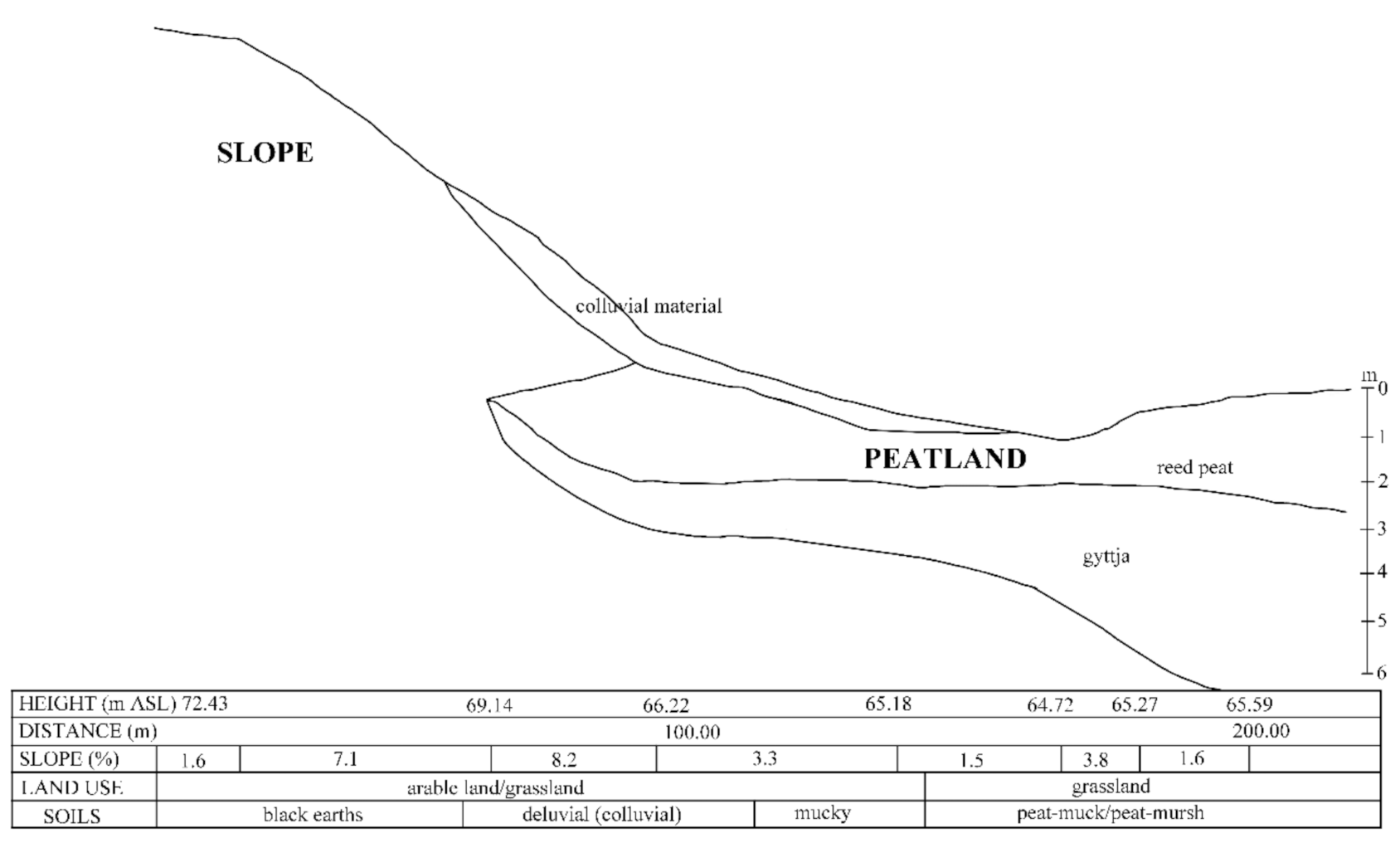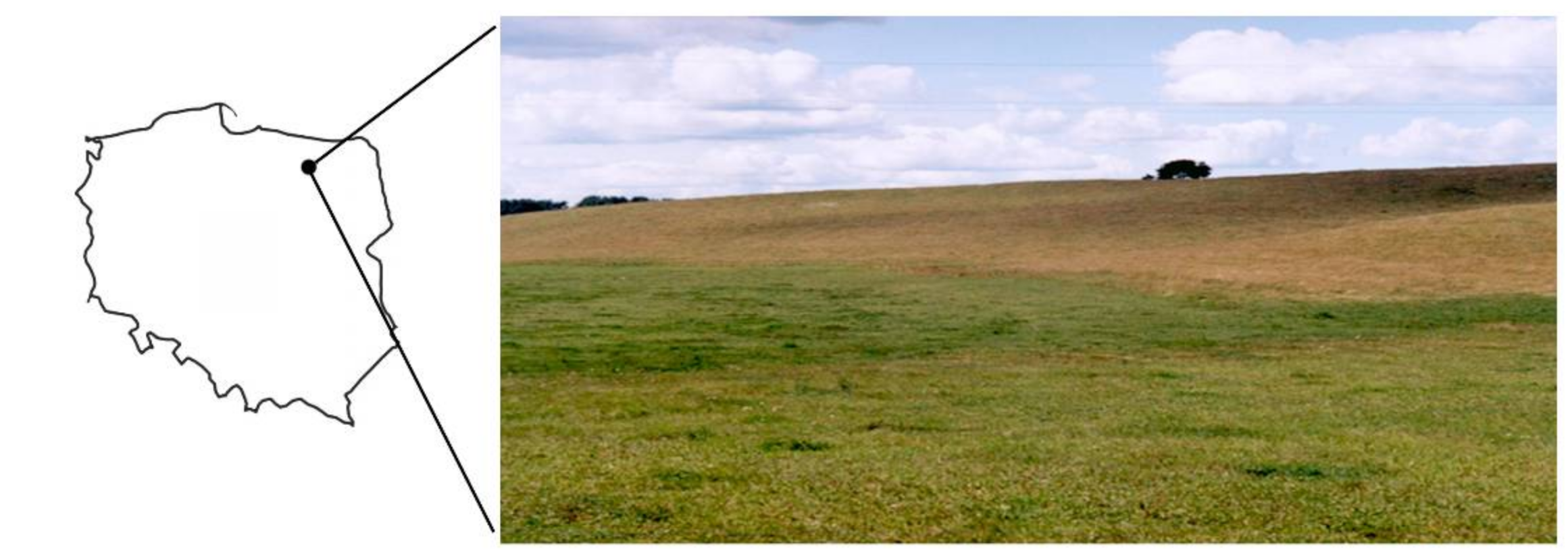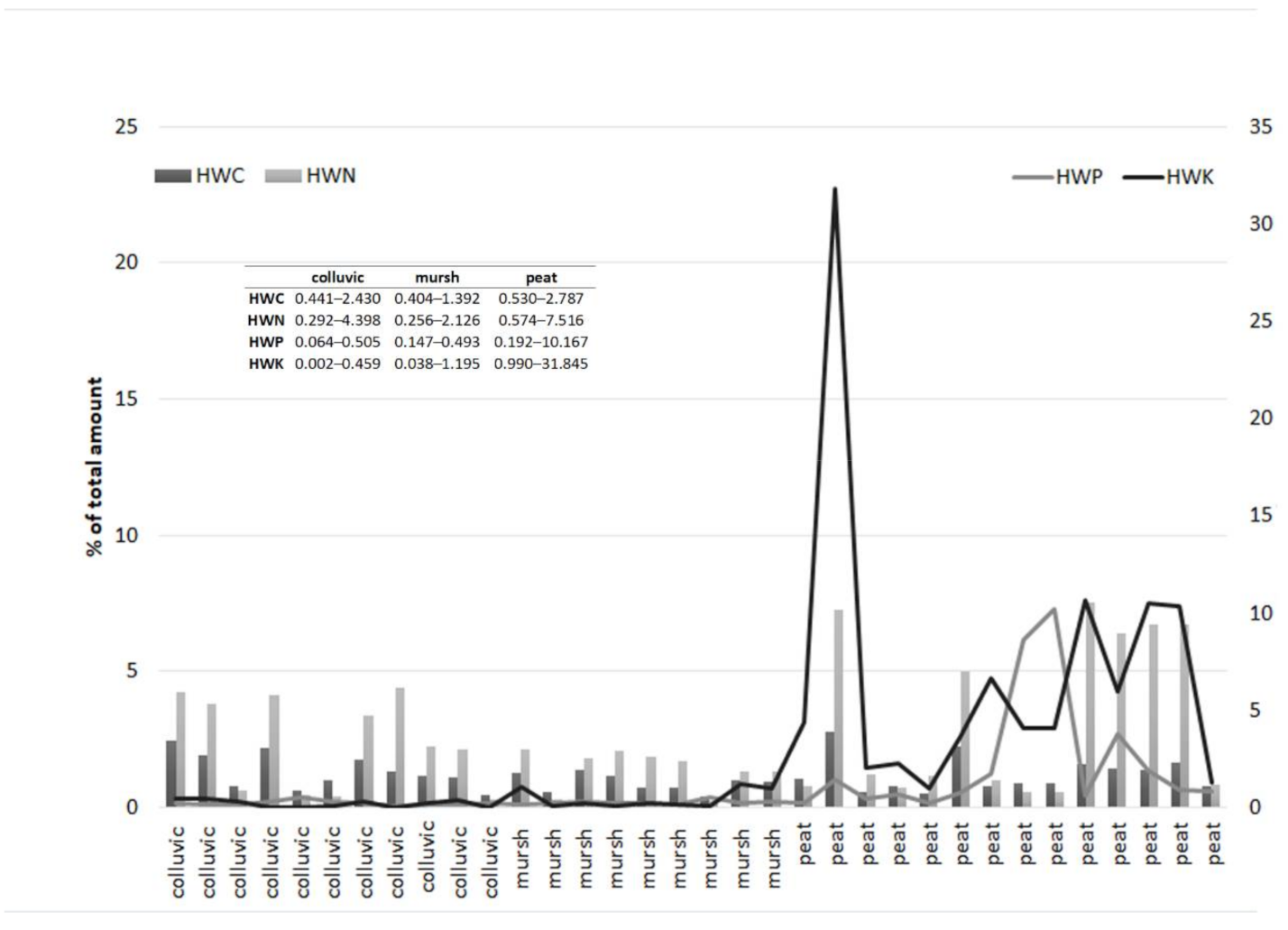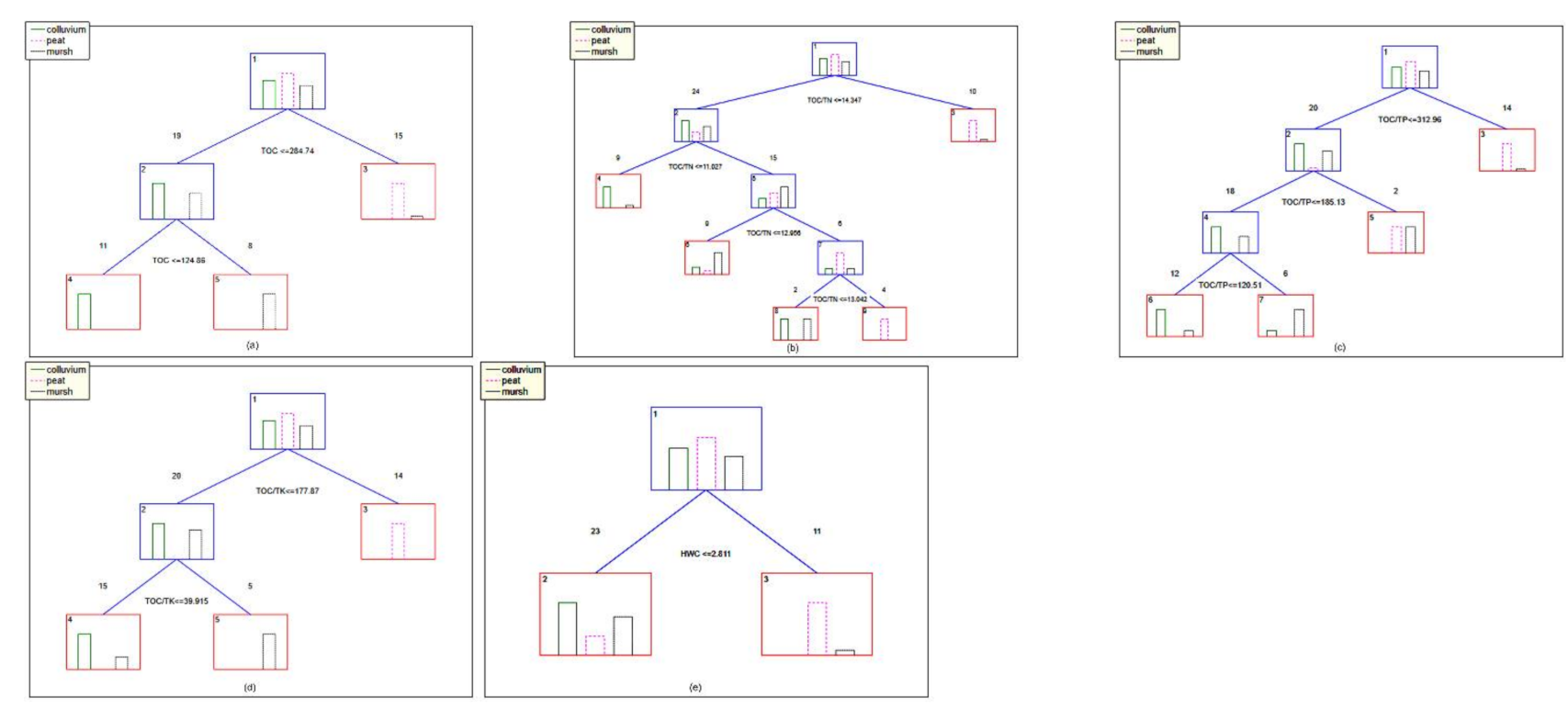Effect of Peatland Siltation on Total and Labile C, N, P and K
Abstract
:1. Introduction
2. Materials and Methods
3. Results
4. Discussion
5. Conclusions
Supplementary Materials
Author Contributions
Funding
Institutional Review Board Statement
Informed Consent Statement
Data Availability Statement
Conflicts of Interest
References
- Blazier, M..; Liechty, H. Assessment of Labile Organic Carbon in Soil Using Sequential Fumigation Incubation Procedures. Jove-J. Vis. Exp. 2016, 8. [Google Scholar] [CrossRef]
- McLauchlan, K.K.; Hobbie, S.E. Comparison of labile soil organic matter fractionation techniques. Soil Sci. Soc. Am. J. 2004, 68, 1616–1625. [Google Scholar] [CrossRef]
- Kalisz, B.; Lachacz, A.; Glazewski, R. Effects of peat drainage on labile organic carbon and water repellency in NE Poland. Turk. J. Agric. For. 2015, 39, 20–27. [Google Scholar] [CrossRef]
- Zhang, X.; Li, Z.; Nie, X.; Huang, M.; Wang, D.; Xiao, H.; Liu, C.; Peng, H.; Jiang, J.; Zeng, G. The role of dissolved organic matter in soil organic carbon stability under water erosion. Ecol. Indic. 2019, 102, 724–733. [Google Scholar] [CrossRef]
- Zhang, L.; Chen, X.; Xu, Y.; Jin, M.; Ye, X.; Gao, H.; Chu, W.; Mao, J.; Thompson, M.L. Soil labile organic carbon fractions and soil enzyme activities after 10 years of continuous fertilization and wheat residue incorporation. Sci. Rep. 2020, 10, 11318. [Google Scholar] [CrossRef] [PubMed]
- Kalbitz, K.; Solinger, S.; Park, J.H.; Michalzik, B.; Matzner, E. Controls on the dynamics of dissolved organic matter in soils: A review. Soil Sci. 2000, 165, 277–304. [Google Scholar] [CrossRef]
- Landgraf, D.; Leinweber, P.; Makeschin, F. Cold and hot water-extractable organic matter as indicators of litter decomposition in forest soils. J. Plant Nutr. Soil Sci. 2006, 169, 76–82. [Google Scholar] [CrossRef]
- Ghani, A.; Sarathchandra, U.; Ledgard, S.; Dexter, M.; Lindsey, S. Microbial decomposition of leached or extracted dissolved organic carbon and nitrogen from pasture soils. Biol. Fertil. Soils 2013, 49, 747–755. [Google Scholar] [CrossRef]
- Kalbitz, K.; Geyer, S. Different effects of peat degradation on dissolved organic carbon and nitrogen. Org. Geochem. 2002, 33, 319–326. [Google Scholar] [CrossRef]
- McDowell, W.H.; Zsolnay, A.; Aitkenhead-Peterson, J.A.; Gregorich, E.G.; Jones, D.L.; Joedemann, D.; Kalbitz, K.; Marschner, B.; Schwesig, D. A comparison of methods to determine the biodegradable dissolved organic carbon from different terrestrial sources. Soil Biol. Biochem. 2006, 38, 1933–1942. [Google Scholar] [CrossRef]
- Simmonds, B.; McDowell, R.W.; Condron, L.M.; Cox, N. Can phosphorus fertilizers sparingly soluble in water decrease phosphorus leaching loss from an acid peat soil? Soil Use Manag. 2016, 32, 322–328. [Google Scholar] [CrossRef]
- Cao, L.; Song, J.M.; Wang, Q.D.; Li, X.G.; Yuan, H.M.; Li, N.; Duan, L.Q. Characterization of Labile Organic Carbon in Different Coastal Wetland Soils of Laizhou Bay, Bohai Sea. Wetlands 2017, 37, 163–175. [Google Scholar] [CrossRef]
- Duval, M.E.; Galantini, J.A.; Martinez, J.M.; Limbozzi, F. Labile soil organic carbon for assessing soil quality: Influence of management practices and edaphic conditions. Catena 2018, 171, 316–326. [Google Scholar] [CrossRef]
- Muciaddas, B.; Lewis, T.; Esfandbod, M.; Chen, C.R. Responses of labile soil organic carbon and nitrogen pools to long-term prescribed burning regimes in a wet sclerophyll forest of southeast Queensland, Australia. Sci. Total Environ. 2019, 647, 110–120. [Google Scholar] [CrossRef] [PubMed]
- Norberg, L.; Bergiund, O.; Bergiund, K. Impact of drainage and soil properties on carbon dioxide emissions from intact cores of cultivated peat soils. Mires Peat 2018, 21, 14. [Google Scholar] [CrossRef]
- Bojko, O.; Kabala, C.; Mendyk, L.; Markiewicz, M.; Pagacz-Kostrzewa, M.; Glina, B. Labile and stabile soil organic carbon fractions in surface horizons of mountain soils—Relationships with vegetation and altitude. J. Mt. Sci. 2017, 14, 2391–2405. [Google Scholar] [CrossRef]
- Kaiser, K.; Kalbitz, K. Cycling downwards—Dissolved organic matter in soils. Soil Biol. Biochem. 2012, 52, 29–32. [Google Scholar] [CrossRef]
- Armstrong, A.; Holden, J.; Kay, P.; Francis, B.; Foulger, M.; Gledhill, S.; McDonald, A.T.; Walker, A. The impact of peatland drain-blocking on dissolved organic carbon loss and discolouration of water; results from a national survey. J. Hydrol. 2010, 381, 112–120. [Google Scholar] [CrossRef]
- Fenner, N.; Williams, R.; Toberman, H.; Hughes, S.; Reynolds, B.; Freeman, C. Decomposition ‘hotspots’ in a rewetted peatland: Implications for water quality and carbon cycling. Hydrobiologia 2011, 674, 51–66. [Google Scholar] [CrossRef]
- Limpens, J.; Berendse, F.; Blodau, C.; Canadell, J.G.; Freeman, C.; Holden, J.; Roulet, N.; Rydin, H.; Schaepman-Strub, G. Peatlands and the carbon cycle: From local processes to global implications—a synthesis. Biogeosciences 2008, 5, 1475–1491. [Google Scholar] [CrossRef] [Green Version]
- Page, S.E.a.B.A.J. Peatlands and Global Change: Response and Resilience. Annu. Rev. Environ. Resour. 2016, 41, 35–57. [Google Scholar] [CrossRef]
- Glina, B.; Gajewski, P.; Kaczmarek, Z.; Owczarzak, W.; Rybczynski, P. Current state of peatland soils as an effect of long-term drainage—Preliminary results of peatland ecosystems investigation in the Grojecka Valley (central Poland). Soil Sci. Annu. 2016, 67, 3–9. [Google Scholar] [CrossRef]
- Kalisz, B.; Lachacz, A.; Glazewski, R. Transformation of some organic matter components in organic soils exposed to drainage. Turk. J. Agric. For. 2010, 34, 245–256. [Google Scholar] [CrossRef]
- Lachacz, A.; Nitkiewicz, M.; Kalisz, B. Water repellency of post-boggy soils with a various content of organic matter. Biologia 2009, 64, 634–638. [Google Scholar] [CrossRef]
- Mendyk, L.; Hulisz, P.; Kusza, G.; Switoniak, M.; Gersztyn, L.; Kalisz, B. Sediment origin and pedogenesis in the former mill pond basin of Turznice (north-central Poland) based on magnetic susceptibility measurements. Bull. Geogr. Phys. Geogr. Ser. 2016, 11, 55–69. [Google Scholar] [CrossRef] [Green Version]
- Banasik, K.; Hejduk, L.; Krajewski, A.; Wasilewicz, M. The intensity of siltation of a small reservoir in Poland and its relationship to environmental changes. Catena 2021, 204, 12. [Google Scholar] [CrossRef]
- Auerswald, K.; Geist, J. Extent and causes of siltation in a headwater stream bed: Catchment soil erosion is less important than internal stream processes. Land Degrad. Dev. 2018, 29, 737–748. [Google Scholar] [CrossRef]
- Kovacs, A.S.; Fulop, B.; Honti, M. Detection of hot spots of soil erosion and reservoir siltation in ungauged Mediterranean catchments. Energy Procedia 2012, 18, 934–943. [Google Scholar] [CrossRef] [Green Version]
- Smolczynski, S.; Kalisz, B.; Orzechowski, M. Sequestration of Humus Compounds in Soils of Northeastern Poland. Pol. J. Environ. Stud. 2011, 20, 755–762. [Google Scholar]
- Smolczynski, S.; Orzechowski, M.; Kalisz, B. Distribution of elements in soil catenas developed in ice-dammed lake and in morainic landscapes in ne poland. J. Elem. 2015, 20, 417–434. [Google Scholar] [CrossRef]
- Sowinski, P.; Orzechowski, M.; Smolczynski, S.; Kalisz, B. Particle-size distribution in soils in various ground moraine catenas in the masurian lakeland. Pol. J. Soil Sci. 2015, 48, 139–150. [Google Scholar] [CrossRef] [Green Version]
- Zakharova, O.A.; Musaev, F.A.; Kucher, D.E.; Vinogradov, D.V.; Ushakov, R.N. Sanding of drained peatlands. BIO Web Conf. 2020, 17, 00089. [Google Scholar] [CrossRef] [Green Version]
- Zaidel’man, F.R.; Kozhevin, P.A.; Shvarov, A.P.; Pavlova, E.B.; Gorlenko, M.V. The effect of different sanding methods on the biological activity and gas regime of drained peat soils. Eurasian Soil Sci. 2001, 34, 207–216. [Google Scholar]
- Smólczyński, S.; Orzechowski, M. Soils of ecotone zones of meltwater basins and slopes in a young glacial landscape of the Mazurian Lakeland. Soil Sci. Annu. 2010, 61, 217–226. [Google Scholar]
- Smólczyński, S.; Orzechowski, M. Sorptive properties of upper-silted organic soils in various landscapes of north-eastern Poland. Pol. J. Soil Sci. 2010, 43, 129–140. [Google Scholar]
- Thaysen, E.M.; Reinsch, S.; Larsen, K.S.; Ambus, P. Decrease in heathland soil labile organic carbon under future atmospheric and climatic conditions. Biogeochemistry 2017, 133, 17–36. [Google Scholar] [CrossRef] [Green Version]
- Smith, H.J.; Foster, R.A.; McKnight, D.M.; Lisle, J.T.; Littmann, S.; Kuypers, M.M.M.; Foreman, C.M. Microbial formation of labile organic carbon in Antarctic glacial environments. Nat. Geosci. 2017, 10, 356. [Google Scholar] [CrossRef] [Green Version]
- Glina, B.; Bogacz, A.; Wozniczka, P. Nitrogen mineralization in forestry-drained peatland soils in the Stolowe Mountains National Park (Central Sudetes Mts). Soil Sci. Annu. 2016, 67, 64–72. [Google Scholar] [CrossRef] [Green Version]
- Quideau, S.A.; Norris, C.E.; Rees, F.; Dyck, M.; Samadi, N.; Oh, S.W. Carbon, nitrogen, and phosphorus release from peat and forest floor-based cover soils used during oil sands reclamation. Can. J. Soil Sci. 2017, 97, 757–768. [Google Scholar] [CrossRef] [Green Version]
- Zhao, S.X.; Ta, N.; Li, Z.H.; Yang, Y.; Zhang, X.; Liu, D.; Zhang, A.; Wang, X.D. Varying pyrolysis temperature impacts application effects of biochar on soil labile organic carbon and humic fractions. Appl. Soil Ecol. 2018, 123, 484–493. [Google Scholar] [CrossRef]
- Stutter, M.I.; Shand, C.A.; George, T.S.; Blackwell, M.S.A.; Dixon, L.; Bol, R.; MacKay, R.L.; Richardson, A.E.; Condron, L.M.; Haygarth, P.M. Land use and soil factors affecting accumulation of phosphorus species in temperate soils. Geoderma 2015, 257, 29–39. [Google Scholar] [CrossRef]
- Orzechowski, M.; Smolczynski, S.; Kalisz, B.; Dlugosz, J.; Sowinski, P. Chemical and mineralogical composition of the holocene soil sediments in north-eastern poland. J. Elem. 2020, 25, 471–485. [Google Scholar] [CrossRef]
- Roper, M.M.; Gupta, V.V.S.R.; Murphy, D.V. Tillage practices altered labile soil organic carbon and microbial function without affecting crop yields. Aust. J. Soil Res. 2010, 48, 274–285. [Google Scholar] [CrossRef]
- Smolczynski, S.; Orzechowski, M.; Kalisz, B.; Krupinski, K. Selected properties of reclaimed mine soils in the area of a former gravel mine in north-eastern Poland. Soil Sci. Annu. 2020, 71, 66–75. [Google Scholar] [CrossRef]
- Kalisz, B.; Łachacz, A.; Klasa, A.; Smólczyński, S.; Orzechowski, M.; Sowiński, P. Water permeability of soils amended with sewage sludge on short-rotation plantations in Europe. Pol. J. Soil Sci. 2015, 48, 131–137. [Google Scholar] [CrossRef] [Green Version]
- Mueller, L.; Wirth, S.; Schulz, E.; Behrendt, A.; Hoehn, A.; Schindler, U. Implications of soil substrate and land use for properties of fen soils in North-East Germany Part I: Basic soil conditions, chemical and biological properties of topsoils. Arch. Agron. Soil Sci. 2007, 53, 113–126. [Google Scholar] [CrossRef]
- Hussain, M.Z.; Robertson, G.P.; Basso, B.; Hamilton, S.K. Leaching losses of dissolved organic carbon and nitrogen from agricultural soils in the upper US Midwest. Sci. Total Environ. 2020, 734, 139379. [Google Scholar] [CrossRef] [PubMed]
- Heinz, M.; Zak, D. Storage effects on quantity and composition of dissolved organic carbon and nitrogen of lake water, leaf leachate and peat soil water. Water Res. 2018, 130, 98–104. [Google Scholar] [CrossRef] [PubMed] [Green Version]
- Li, J.; Wen, Y.C.; Li, X.H.; Li, Y.T.; Yang, X.D.; Lin, Z.; Song, Z.Z.; Cooper, J.M.; Zhao, B.Q. Soil labile organic carbon fractions and soil organic carbon stocks as affected by long-term organic and mineral fertilization regimes in the North China Plain. Soil Tillage Res. 2018, 175, 281–290. [Google Scholar] [CrossRef] [Green Version]
- Zhou, W.-J.; Sha, L.-Q.; Schaefer, D.A.; Zhang, Y.-P.; Song, Q.-H.; Tan, Z.-H.; Deng, Y.; Deng, X.-B.; Guan, H.-L. Direct effects of litter decomposition on soil dissolved organic carbon and nitrogen in a tropical rainforest. Soil Biol. Biochem. 2015, 81, 255–258. [Google Scholar] [CrossRef]
- Heller, C.; Zeitz, J. Stability of soil organic matter in two northeastern German fen soils: The influence of site and soil development. J. Soils Sediments 2012, 12, 1231–1240. [Google Scholar] [CrossRef]
- Williams, B.L.; Silcock, D.J. Impact of NH4NO3 on microbial biomass C and N and extractable DOM in raised bog peat beneath Sphagnum capillifolium and S-recurvum. Biogeochemistry 2000, 49, 259–276. [Google Scholar] [CrossRef]





| Soil Sample | OM | TN | TOC | TP | TK | HWC | HWN | HWP | HWK |
|---|---|---|---|---|---|---|---|---|---|
| Colluvium | 187.0 (24.4) | 7.9 (30.4) | 77.2 (29.0) | 1.3 (89.9) | 5.1 (60.5) | 0.9 (35.9) | 0.2 (64.0) | 0.002 (65.8) | 0.009 (96.8) |
| Mursh | 405.2 (30.8) | 16.2 (18.0) | 201.4 (31.2) | 1.2 (23.2) | 3.9 (49.9) | 1.8 (43.2) | 0.2 (47.5) | 0.003 (60.3) | 0.010 (68.2) |
| Peat | 760.3 (17.9) | 22.3 (18.7) | 391.9 (13.9) | 0.6 (64.6) | 0.5 (60.0) | 5.1 (62.9) | 0.7 (83.7) | 0.008 (129.5) | 0.024 (79.9) |
| Parameter | TN | TOC | TP | TK | TOC/TN | TOC/TP | TOC/TK |
|---|---|---|---|---|---|---|---|
| HWC | 0.438 ** | 0.766 * | −0.380 | −0.562 * | 0.772 * | 0.615 * | 0.857 * |
| HWN | 0.246 | 0.627 * | −0.339 | −0.477 ** | 0.816 * | 0.712 * | 0.830 * |
| HWP | 0.571 * | 0.335 | −0.133 | −0.233 | 0.083 | 0.126 | 0.037 |
| HWK | 0.442 ** | 0.574 * | −0.364 | −0.416 | 0.339 | 0.299 | 0.474 ** |
| HWC/HWN | 0.213 | 0.118 | −0.118 | 0.084 | −0.136 | −0.086 | −0.080 |
| HWC/HWP | 0.124 | 0.478 ** | −0.339 | −0.389 | 0.706 * | 0.516 ** | 0.691 * |
| HWC/HWK | −0.351 | −0.299 | 0.668 * | −0.006 | −0.121 | −0.150 | −0.134 |
Publisher’s Note: MDPI stays neutral with regard to jurisdictional claims in published maps and institutional affiliations. |
© 2021 by the authors. Licensee MDPI, Basel, Switzerland. This article is an open access article distributed under the terms and conditions of the Creative Commons Attribution (CC BY) license (https://creativecommons.org/licenses/by/4.0/).
Share and Cite
Smolczynski, S.; Kalisz, B.; Urbanowicz, P.; Orzechowski, M. Effect of Peatland Siltation on Total and Labile C, N, P and K. Sustainability 2021, 13, 8240. https://doi.org/10.3390/su13158240
Smolczynski S, Kalisz B, Urbanowicz P, Orzechowski M. Effect of Peatland Siltation on Total and Labile C, N, P and K. Sustainability. 2021; 13(15):8240. https://doi.org/10.3390/su13158240
Chicago/Turabian StyleSmolczynski, Slawomir, Barbara Kalisz, Pawel Urbanowicz, and Miroslaw Orzechowski. 2021. "Effect of Peatland Siltation on Total and Labile C, N, P and K" Sustainability 13, no. 15: 8240. https://doi.org/10.3390/su13158240






